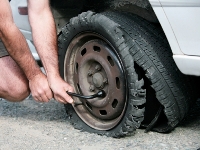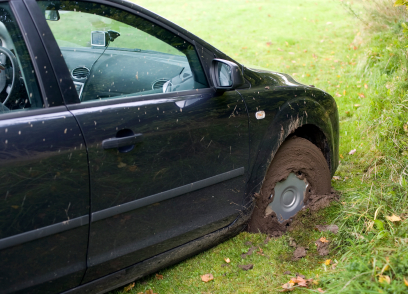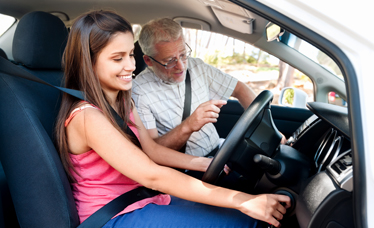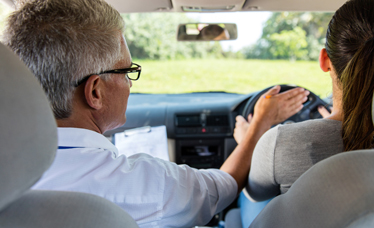Chapter 3 – Section 2
Vehicular Emergencies
Regular maintenance of your vehicle helps prevent most breakdowns. However, even a well-maintained vehicle can run into the occasional problem, so you need to be able to handle mechanical emergencies quickly. Below are some common emergency driving situations and how to respond:
-
A. Brake Failure
-
Many factors can cause brake failure. Two of the most common are wet brakes that result from driving through puddles and brake overheating from prolonged use or hard driving. There is a requirement that every vehicle on the road in New Jersey be in proper working order with functional equipment; this requirement applies to brakes.[1] In passenger vehicles, there are two main braking systems: a hydraulic four-wheel brake system, and a mechanically operated rear wheel parking brake.
All brakes and brake components should be maintained in good condition at all times. Properly maintained brakes are not only required by law but are essential for the safe operation of the motor vehicle. It is advisable to check the condition of a vehicle’s brakes periodically to ensure that they function properly. An emergency situation would involve a total failure of the brakes along with the vehicle gaining momentum and speed while heading downhill. If total brake failure occurs, there are several corrective actions you can take. Procedures to follow include:
-
1. Pump the Brakes
-
A brake line may be clogged and brake fluid may not be flowing properly. Pumping helps to distribute brake fluid adequately. Try this solution first.
NOTE: Do not pump Anti-Lock Brakes (ABS) – To initiate ABS brakes, you must fully compress the brake pedal to near maximum capacity. This causes the computer to pulsate the brake pads automatically as long as pressure is held down. The average adult male heart pulsates at a rate of about 70 beats per minute.
-
2. Downshift
-
The goal with downshifting is to create more friction in the transmission. Shifting to a lower gear creates more tension in the transmission and slows down the vehicle. Downshifting is also effective in an automatic transmission vehicle. Keep your foot off the gas while downshifting.
-
3. Apply the Parking Brake
-
Apply the parking brake gradually, with no abrupt movements. Sudden and violent tugging at the parking brake may cause loss of vehicle control and overturning. Your goal is to slow down the vehicle without locking up your wheels.
Note:(Many drivers rarely use the parking brake because they mistakenly believe that a vehicle parked while still in gear is unlikely to roll. The parking brake, however, is in a motor vehicle for a reason and its value is immeasurable. A properly functioning parking brake should be used at all times when a vehicle is in the parked position. The parking brake should be sufficient to hold the vehicle on any grade and capable of locking the wheels to limit any vehicle movement.
-
4. Attempt to Warn Others
-
When your vehicle’s brakes are not functioning, you should honk the horn or make other efforts to notify the drivers around you out of fairness to them. An out-of-control vehicle is a hazard to all on the road.
-
5. Sideswipe Objects to Reduce the Vehicle’s Speed
-
Sideswiping involves slowing down the vehicle by deflecting the car off other objects on the road. No object should ever be hit head-on, nor should objects like curbs be hit, because they could cause the car to overturn. Guardrails and parked cars are good objects to sideswipe, as they might gradually slow down the vehicle.
-
6. Shift into Reverse
-
If all else fails, shift into reverse. However, do this only as a last resort. This action grinds all the gears of the transmission together and also slows down the vehicle. The transmission will be destroyed, but your life may be saved.
NOTE: Never turn off the vehicle in an attempt to stop. This action will cause other car functions, such as steering, to also fail.
-
-
B. Tire Blowout
-
A simple flat is often manageable when driving. A blowout, however, includes the shredding of a tire to the point where you are left driving on a rim with no control of the vehicle. If you need to swerve into an object, do so into something that will “give,” reducing the chance of injury. Sound the horn and flash the lights to alert other drivers that there is a problem. Often the first reaction when a blowout occurs is to slam down on the brakes. This instant human reaction, however, only causes more damage. You should instead hold the steering wheel firmly and keep the vehicle moving straight ahead. Below are ways to prevent a collision if a blowout occurs:
-
1. Left Front Tire
-

A blowout is the complete failure of a tire and often leaves the vehicle riding on just the wheel rim.
If the left front tire blows out, the car pulls to the left, and the steering becomes quite heavy. Do not fight the pull, but instead grab hold of the steering wheel with both hands, gain control of the vehicle, and gradually slow it down. Do not brake suddenly or forcefully.
-
2. Right Front Tire
-
If the right front tire blows out, the car pulls to the right and the steering becomes quite heavy. Do not fight the pull, but instead grab hold of the steering wheel with both hands, gain control of the vehicle, and gradually slow it down. Do not brake suddenly or forcefully. At speeds below 55 mph, a blowout should be an easily controlled emergency.
-
3. Rear Tires
-
A blowout of one of the rear tires causes the car to fishtail and feel unstable in the rear. Control of the steering wheel is vital, as is awareness of any other vehicles around. Slowing down the car gradually reduces the potential for a collision.
-
-
C. Steering Wheel Locks
-
The ignition key should never be moved or adjusted while the vehicle is in motion, so this problem should never occur. However, if the steering wheel lock, slow down the vehicle as quickly as possible by whatever means are necessary to minimize the chance of losing control of the vehicle. In 1873, James Sargent patented a time lock mechanism which was the basis for those used in modern bank vaults.
-
D. Car Stalls/Breakdowns
-
The actions to take if your car stalls according to time and location, among other factors. The goal is to show other drivers that your vehicle is disabled and road service or a tow is required. These rules usually apply:
- Try to get your car off the road. Removing your car from the road reduces the possibility of another vehicle hitting you. However, do not attempt to push the car off the road by yourself. If the vehicle is left on the road for any reason, the vehicle must have its hazard lights on. A dark vehicle on the road is a collision waiting to happen.
Note: The purpose of emergency flashers is to alert other drivers that an emergency situation or collision is ahead. If the emergency flashers do not work, put on the vehicle’s turn signals instead.
- If it is safe to do so, remain in the car and lock the doors. Walking aimlessly on the side of the road looking for assistance is unwise and unsafe. Sitting in the locked vehicle waiting for tow service or law enforcement is the safest and most prudent move. Law enforcement is always alert to disabled vehicles. If it is not safe to stay in the car due to the possibility that another vehicle may crash into it, such as near traffic or in fog, you and all your passengers should get out of the car. Exit through the passenger side, not the driver side, and stay well away from traffic but as close as safely possible to your car and where you can observe oncoming traffic.
Note: When the vehicle is disabled on a highway, always attempt to pull to the shoulder, and try to warn approaching traffic when necessary. (Use signals, hazard lights or flares.)
- Try to get your car off the road. Removing your car from the road reduces the possibility of another vehicle hitting you. However, do not attempt to push the car off the road by yourself. If the vehicle is left on the road for any reason, the vehicle must have its hazard lights on. A dark vehicle on the road is a collision waiting to happen.
For more information on the dangers of stalling, see the video at the bottom of the section.
-
E. Accelerator Sticks
-
A stuck accelerator is usually not a major problem, and it can be solved by stepping repeatedly on the accelerator. If the vehicle’s speed continues to increase, however, either step on the clutch to disengage the gears or shift the vehicle into the neutral position. As a last resort, you can turn off the vehicle, but this also turns off your power steering.
-
F. Fan Belt Sticks or Breaks
-
The vehicle will probably overheat if there is a problem with the fan belt. You should turn on the heater to the highest setting. This draws much of the heat from the engine block, helping to cool down the vehicle. Do not drive the vehicle for more than a few minutes in this condition.
-
G. Steering Problems
-
Do not try to solve steering problems on the road while driving. Slow down immediately. If the power steering fails, you will have to work hard to steer the vehicle, but you will not lose full control. Use your hazard lights and headlights to warn others that there is a problem.
-
H. Headlight Failure
-
- Try switching the headlights on and off a few times.
- Try to adjust the dimmer switch.
- Try turning on the parking lights, hazard lights, or turn signals.
-
I. Hood Latch Failure
-
If the hood latch fails and the hood opens while you are driving, do the following:
- Slow down your vehicle immediately.
- Put your head out of the window and look around the hood.
- Use the center marking lines or lanes as a guide.
- Pull off the road as soon as possible, as you pose a risk to yourself and other drivers.
- Turn on your hazard lights.
-
J. Stuck Tires
-

If your tires get stuck, shift into low gear, angle the wheels straight ahead, and pull forward and backward repeatedly
When tires get stuck in the snow or a similar substance like mud, shift into low gear and attempt to pull forward as much as possible, with the wheels angled straight ahead. When wheels are turned to the side, they provide a greater resistance to forward and reverse motions. Do the same maneuver in reverse, and then forward again, without spinning the tires. This forward and backward motion should be repeated until the car moves free. A wood object such as a branch or board may be used under the tires if they are submerged very deeply. The use of snow chains helps reduce the chances of the tires getting stuck.
-
K. Carbon Monoxide Poisoning
-
Beware of carbon monoxide poisoning. Vehicle motors give off carbon monoxide, which is a deadly gas. To avoid carbon monoxide poisoning:
- Do not leave the motor running in a garage.
- Do not leave the motor running with the windows closed when you park your vehicle.
- Do not use the heater or air conditioner in a parked vehicle with the windows closed.
- Do not leave the vents open when following closely behind another vehicle.
- Do not drive with a defective muffler or exhaust system.
Tips to Minimize the Chance of a Collision
The best way to deal with a potential collision is prevention and avoidance. Here are a few tips to practice:
- Be alert and well-rested.
- Always expect the unexpected. Never assume drivers will follow through on what they appear to be doing.
- Look about 12 to 15 seconds or 1/4 mile ahead and keep your eyes moving.
- Maintain a following distance of 3 to 4 seconds as needed.
- Look for potential hazards, such as poor road conditions or a wreck ahead.
- Have an escape route available when possible.
- Check the vehicles behind you often.
- Adjust your speed to suit conditions.
- Plan ahead.
- Honk your horn when appropriate (You are allowed to use your horn only to prevent a collision or warn others of a potential collision)
- Watch out for trucks and buses.
- Watch out for pedestrians and bicyclists.
- Signal and communicate your intentions.
Remember, practicing good vehicle maintenance can greatly reduce the chances of emergency situations on the road.
Video: “Stalled Smashup”
If your vehicle begins to stall, you should have just enough power to pull over to the shoulder if you act quickly. However, in some cases, you may not be able to get off the road and away from traffic. This creates an extremely hazardous situation for you as well as others who use the road. Do you know what to do if your vehicle stalls on the highway? Watch the following video to learn how to do the right thing in a stalled vehicle situation.
Make your vehicle as visible as possible because you want other drivers to be able to see it. Be sure that you and all your passengers exit the vehicle and stay as far as possible from traffic if you stopped in a dangerous location. Your life is more important than your vehicle.
1 New Jersey Statute 39.3-68















